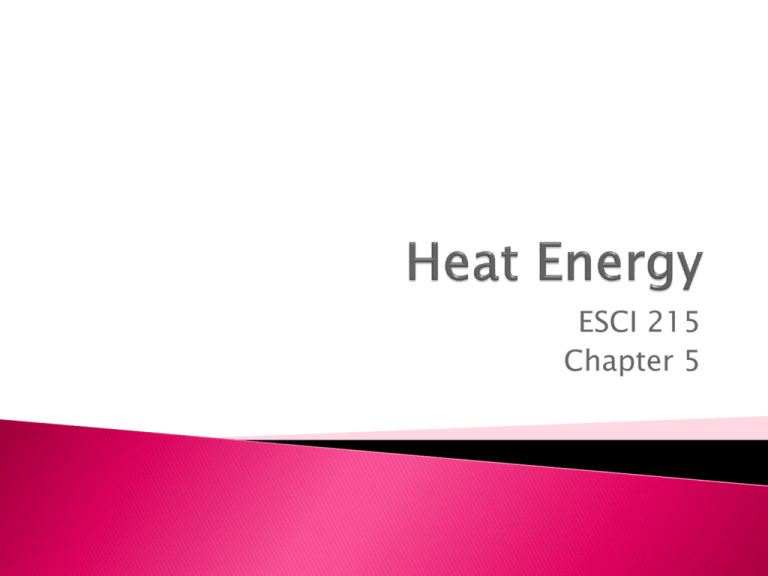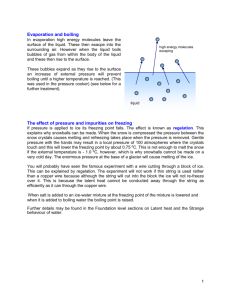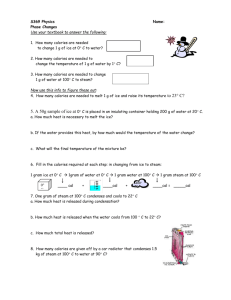Chatper 5 – Heat Energy
advertisement

ESCI 215 Chapter 5 In 1714 a German-Dutch scientist named Gabriel Fahrenheit developed the first scale to be used frequently ◦ Scale included: boiling, freezing, and zero points ◦ He selected an arbitrary “zero” point (32°F) so that winter temperatures would still read as positive values ◦ He selected the boiling point to be represented by 212°F, which was 180 degrees above the boiling point In 1742, Anders Celsius, a Swedish astronomer invented the Celsius scale Temperature scale with: ◦ Freezing point of water is the zero point (0°C) 100 degrees between the freezing and boiling points Works well with decimal systems, so was easy for scientists to use Lord Kelvin of England developed this scale Absolute zero = the lowest possible temperature (0K) There are 273 degrees between absolute zero and the freezing point (273K) There are 100 degrees between the freezing and boiling points (373K) Using 0K to represent absolute zero meant that no temperature could go below “zero” using this scale Heat and temperature are different ◦ Temperature scales measure temperature (not heat) ◦ Event 5-A shows the difference between temperature and heat The nail and bolt have the same temperature, but the bolt has more temperature See diagram page 72 Temperature – how hot or cold something; measured in degrees (F, C, K) Heat – a quantity of energy something has Heat ◦ The energy a substance has due to motion of its molecules Increased heat = increased molecular motion Decreased heat = decreased molecular motion ◦ Absolute zero = the point where all molecular motion stops and a substance has no heat Scientists have never been able to get a substance to this point Heat is measured in calories, British thermal units (Btu), or joules Calorie – amount of heat needed to raise the temperature of 1 gram of water by 1 degree Celsius ◦ Common measurement Btu – heat needed to raise 1 pound of water by 1 degree Fahrenheit ◦ Used sometimes (i.e. furnace) Joule –work done by 1 newton of force or weight moving a body through 1 meter ◦ Used by scientists 1 gram of ice at 0°C or 1 gram of water at 0°C 1 gram of water at 100°C or 1 gram of steam at 100°C ◦ Water ◦ Steam Why? ◦ When matter changes from a state of slower molecular movement to a state of higher molecular movement, heat is required Change from solid to liquid requires heat Heat is needed to melt ice or to change water to steam Heat of fusion and heat of vaporization are needed 1 calorie of heat increases temperature of 1 gram of ice by 1 degree If ice is -10C: ◦ How many calories are needed to get to 0C? 10 calories melting point - but more heat is needed to change state Heat of Fusion - change of state from solid to liquid takes 80 calories How many calories are needed to get to 100C? 100 calories Vaporization point – but more heat is needed to change state Heat of Vaporization – change of state from liquid to gas takes 540 calories Figure 5.3 page 74 in Text Where does the heat come from to change the state of matter? ◦ It can come from anywhere Air Your body Stove Hot plate ◦ When you hold an ice cube, heat is taken from your hand and used to melt the ice – leaving your hand feeling cold ◦ When you step out of a shower, heat is taken from your body and used to turn water into steam – leaving you feeling cool Event 5-B shows that there is no temperature change unless there is a change in the amount of heat present Event 5-C demonstrates that heat of fusion is what causes the ice to melt by taking heat from the salt and using it to melt the ice ◦ This causes the temperature of the salt water to drop below freezing ◦ This cooled water evaporates and forms frost on the beaker There are many sources of heat Grouped into 4 categories: Mechanical Chemical Electrical Nuclear Friction Rearranging molecules Lights Sun and stars Bending Flame Toasters Atomic fission Hammering Water and plaster Heaters Atomic fusion Pressure Sulfuric acid and sugar Stoves Nuclear power reactor Table 5.2 page 77 of text Event 5-D Shake heat into a Bottle ◦ Demonstrates a mechanical source of heat ◦ Sand hits top and bottom of bottle and this friction causes heat ◦ Insulation around bottle is to make sure that the heat is not coming from your hands Event 5-E Wire Heater ◦ Demonstrates a mechanical source of heat ◦ Bending the wire causes heat to build at the bend Some nails have adhesive on the shaft. This adhesive does not do anything at room temperature, but it melts when nailed into wood. Why? Conduction Convection Radiation Definition Transfer of heat from one molecule to another Transfer of heat by movement of fluids Transfer of energy by waves through space Examples Silver spoon Clothes Iron Cookware Winds (weather) Chimney draft Boiling water Sun’s heat Heat lamp Electric heater Table 5.3 page 79 in text Transfer of heat from 1 molecule to another Event 5-G Ice Preservation Race ◦ Purpose – learn about movement of heat by conduction Could be used after learning about conduction to show their understanding of the concept Could be used before learning about conduction to have them explore ways to slow heat transfer ◦ 2 important rules: No refrigerators, ice, or outdoors Do not let ice touch anything that will soak up water – water needs to be measured to find the winner ◦ Best results achieved when: Size of container is small – reduces the area to be protected from heat Conductivity is decreased – tin conducts heat well so need to insulate the ice cube from the tin Good conductors ◦ Metals are usually the best conductors of heat (especially copper, silver, aluminum) Poor conductors ◦ Called insulators ◦ Glass, paper, wood, plastic rubber Event 5-H Two toned paper shows the effects of good and poor conductors ◦ Wood is a poor conductor of heat so the paper scorches more than copper which conducts the heat away Event 5-I Candle Snuffer shows a good conductor ◦ The candle goes out because the copper carries the heat away from the candle, not because of oxygen loss Transfer of heat by movement of fluids (gas or liquid) Convection current - Liquids expand and become lighter when heated Event 5-J The Mixed-Up Bottles shows a convection current ◦ Hot water is less dense and rises ◦ Cold water is denser and sinks Event 5-K The Circling Sawdust shows the movement of water Figure 3.7 page 80 in text Event 5-L Does Air Move In or Out shows the convection currents in air ◦ One window is open on the bottom and another is open at the top to show the air movement in the room Cold air enters the room through the lower opening and hot air leaves the room through the higher opening Event 5-M Convection Tester #1 shows that air rises when heated ◦ Air is heated by the bulb and rises, causing the coil to spin (see figure 5.9 on page 81) Energy travels, at the speed of sound, from a source to an object; it travels through space ◦ Ex: heat from the sun This energy is only converted to heat when it hits a non-transparent object ◦ On a cold day the sun’s light heats up a window sill, but the window’s glass is still cold Substances vary in their ability to reflect and absorb radiation ◦ Event 5-N Which is the “warmer” colour? and Event 5-O Hot Car show that black absorbs heat well and white reflects most of the heat energy that hits it All objects whose temperature is above absolute zero radiate (give off) some heat ◦ The temperature must be very hot before we can feel it Event 5-P Heat from Light shows the radiation that a light bulb gives off ◦ The heat below the light bulb is from radiation ◦ The heat above the light bulb is from radiation and convection If you had a fire in a fireplace, where would you feel the radiant heat? Where would you feel the convection heat? Almost all substances expand when heated and contract when cooled ◦ Index of expansion - the amount of expansion or contraction ◦ When heated, molecules vibrate more and take up more space Water is an exception ◦ It expands and contracts like other substances only when it is above 4°C ◦ Below 4°C it expands when cooled ◦ This allows ice to form on top of water instead of at the bottom Interesting facts: ◦ Sears Tower in Chicago is about 15 centimeters taller on a hot summer day than on a cold winter day ◦ A 2km bridge can expand and contract about 1m between summer and winter ◦ Concrete highways and sidewalks have separation or joints to allow them to expand and contract without breaking Event 5-Q Dancing Dimes shows how air expands when heated, rises up and pushes past the coin ◦ When will the coin stop “dancing”? When the air inside the bottle reaches room temperature Note: the coin must have an airtight seal – wet the rim on the bottle with water Event 5-R Jumping Juice (see safety note) ◦ Hot water on outside of beaker causes the coloured water to rise in the tube. Why? ◦ Cold water on the outside of beaker causes the coloured water to drop in the tube. Why? Event 5-S The Sagging Solid shows that different metals have different expansion rates ◦ Metal strip is bimetal (iron side and brass side) ◦ The metal that expands more will be on the outside of the curve ◦ Which metal expands more? Similar to 2 humans running a track. The outer lane is longer, so the runner has to run farther and faster to keep up with the runner in the inner lane Event 5-T Expansion Meter shows how heat causes metal to expand ◦ What happens to the weight as the wire is heated? See Safety Caution Fig 5.12 page 85 in text Event 5-U Expansion of Gases shows how much air expands when heated ◦ Air expands as it heats, rises and travels along the tube and into the inverted bottle Fig 5.13 page 86 in text Fire is a chemical source of energy It releases energy by rearranging the atoms of the object that is burning ◦ A candle is a hydrocarbon – made of hydrogen (H) and carbon (C) atoms ◦ When it burns, oxygen (O) is bonded with the hydrogen and carbon atoms ◦ Carbon dioxide (CO2) and water (H2O) are produced ◦ Event 5-V Water from Fire shows how fire releases water Hydrogen atoms of candle combine with oxygen atoms in air to produce water which condenses on the cold glass Fire Triangle – the 3 things fire needs in order to burn: 1. Fuel 2. Oxygen 3. Kindling temperature – the temperature that something will ignite at (different for different materials) Fire will go out when 1 of these 3 things is missing Fire is a form of rapid oxidation because it uses oxygen quickly Event 5-W Boil Water in a Paper Cup shows how flame is extinguished when the kindling temperature is missing ◦ The water in the paper cup takes the heat away from the paper quickly, so the paper never reaches the kindling temperature ◦ The paper cup never burns, but the water boils ◦ Caution: Do not use plastic or Styrofoam cups. Why? Plastic will melt Styrofoam is a good insulator so water cannot take the heat away fast enough and the styrofoam will burn, releasing fumes Event 5-X Kindling Temperatures shows that different substances have different kindling temperatures ◦ Some substances will ignite quickly at low temperatures ◦ Some substances will take more time and higher temperature to ignite ◦ Caution: Do this in an area with lots of ventilation due to fumes and odours When oxygen combines with other materials, it produces heat Slow oxidation occurs when the heat is so little that you cannot detect it ◦ When iron combines with oxygen to produce rust, it produces heat that is not noticeable Event 5-Y Heat from Grass is a demonstration of slow oxidation ◦ Heat is produced in the moist grass as microorganisms use the moisture to break down grass Moist grass breaks down in 1-2 days Dried hay (a type of grass) has no moisture, so can be stored by farmers in a barn for years Task: Groups of 2-4 discuss and explain the following in writing: “If hot air rises, then why is it so cold in the mountains?” Tell students to use the words: conduction, convection and radiation in their answer Evaluation:





